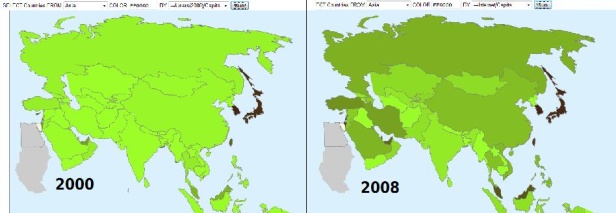MapStats/DigitalDivideLesson: Difference between revisions
(New page: '''The Digital Divide''' is commonly used to describe the gap between those with and without access to computers and internet technology. In this lesson we will: * Consider the value of c...) |
|||
| Line 13: | Line 13: | ||
One wonders what kind of online communities and resources will exist once all countries gain widespread internet access. |
One wonders what kind of online communities and resources will exist once all countries gain widespread internet access. |
||
Note: include topic about languages |
|||
==Mapping the Divide== |
==Mapping the Divide== |
||
Revision as of 01:44, 16 May 2009
The Digital Divide is commonly used to describe the gap between those with and without access to computers and internet technology.
In this lesson we will:
- Consider the value of computing and internet technology
- Read and research examples of efforts to bridge the Digital Divide
- Use maps to better understand the Digital Divide
Value of Technology
Computers and the internet allow people unparalleled access to education, information, and media. It also empowers people to share their work and participate in high-tech jobs.
Bridging the Divide
The OLPC project is one of many programs working to bridge the Digital Divide.
One wonders what kind of online communities and resources will exist once all countries gain widespread internet access.
Note: include topic about languages
Mapping the Divide
View the world map of internet users in 2000. This gives you a good idea of how likely it would be for you to find a site or get an e-mail from each country. It appears that most users were concentrated in a few countries.
Now view the world map of internet users per capita in 2000. Dividing each countries' internet users by the population allows larger and smaller countries to be compared by the fraction of people with internet access. The United States remains one of the leading countries, but now European countries are also darker green. A stark digital divide exists between these nations and the others.
Now map users per capita of 2008. Try multiple continents to see how several countries are affected.
In only 8 years, the digital divide is closing for many countries. But there are several countries in this map which remain pale green. It will be a few more years before high-speed internet is available in many countries, especially in central and southern Africa. Many countries, like Mongolia, are working to bridge the gap with laptops for school children and other projects. Other countries, such as North Korea, reject internet access for political reasons.
Research Project
- Choose a country which did not have much internet access in 2000.
- Why might internet access be useful to people in this country?
- By 2008, did this country have better internet access?
- What is being done in this country to bring more people online?
- Does OLPC, LiteracyBridge, or Room to Read work in this country?
- Is there a government office for ICT (Information and Communication Technology)?
